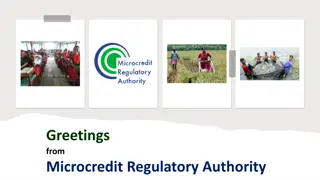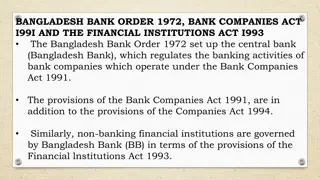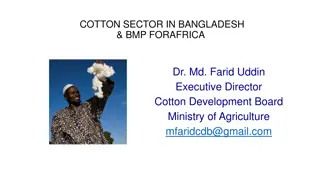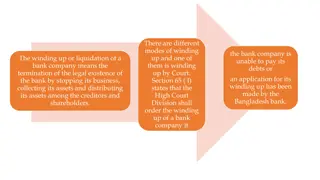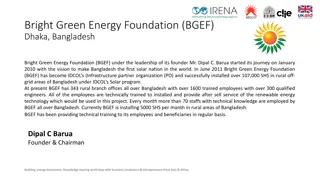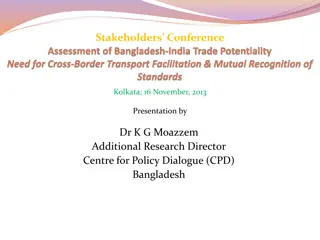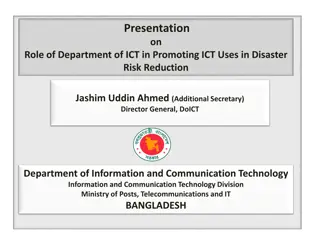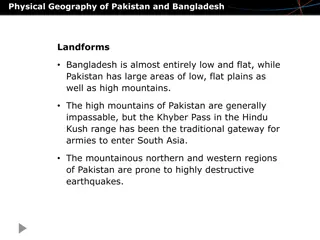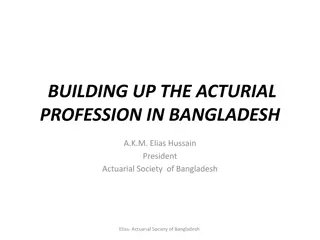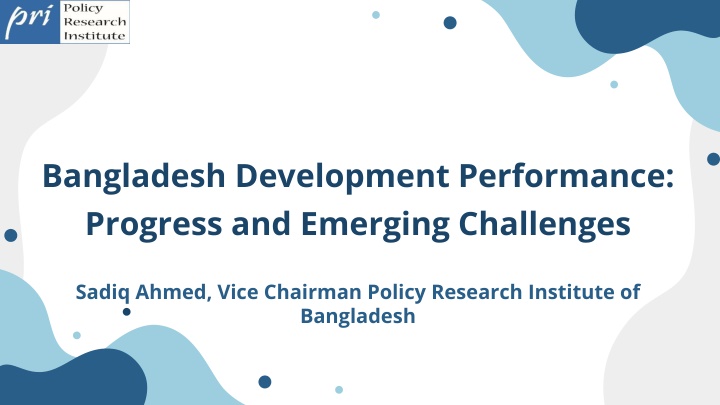
Bangladesh Development Progress and Challenges: A Comprehensive Overview
"Explore Bangladesh's remarkable development journey from poverty to prosperity since 1972. Learn about key indicators, growth drivers, and structural changes in production that have contributed to the country's advancement. Discover how investments, national savings, and export surges have fueled GDP growth, transforming Bangladesh into a lower middle-income country with significant improvements in human development indices."
Download Presentation

Please find below an Image/Link to download the presentation.
The content on the website is provided AS IS for your information and personal use only. It may not be sold, licensed, or shared on other websites without obtaining consent from the author. If you encounter any issues during the download, it is possible that the publisher has removed the file from their server.
You are allowed to download the files provided on this website for personal or commercial use, subject to the condition that they are used lawfully. All files are the property of their respective owners.
The content on the website is provided AS IS for your information and personal use only. It may not be sold, licensed, or shared on other websites without obtaining consent from the author.
E N D
Presentation Transcript
Bangladesh Development Performance: Progress and Emerging Challenges Sadiq Ahmed, Vice Chairman Policy Research Institute of Bangladesh
Long Term Progress with Development In 1972 Bangladesh was one of the poorest countries in the world. Per capita GNI was only $110; poverty rate was in the 80% plus range, and human capital was in dire straits. In 2015 Bangladesh per capita GNI crossed the threshold of World Bank defined lower middle -income country and in 2019 per capita GNI reached USD2209. Poverty declined from 80% to 22% Progress with human development was remarkable: --Life expectancy rose from 45 years to 72 years ---Infant mortality fell from 140/1000 to 22/1000 ---Adult literacy rate climbed from 20% to 74% --Population growth rate decelerated from 2.4% to 1.2% . Table 1: Development Performance 1972-2019 Indicators 1972 2000 2019 GNI per capita ($) 110 581 2209 Poverty (UPL) (%) 82 52.3 21.8 Life expectancy (years) 44.9 63.6 72.3 Infant mortality (%) 140 58 22 Adult Literacy (%) 20.2 52.8 73.9 Population growth rate (%) 2.4 1.4 1.2 [1]UPL 1972 refers to 1973 based on daily intake of 2122 calories per person.
Progress with Growth The single most important determinant of Bangladesh development performance was the acceleration in GDP growth. Following some fluctuations in the early years owing to political turbulence, GDP growth took off substantially since 1990, accelerating from less than 4% in the late 1980s to 6.9% over 2011-2019. Average GDP growth rate was a remarkable 6% per year over a 30 year between 1989 and 2019. Figure 1: Bangladesh 5 year Average GDP Growth Path (% per year) 8 6.9 7 6 6 5.4 5.2 5 4.4 4.2 3.8 3.6 4 3 2 1 0 1975-1980 1981-1985 1986-1990 1991-1995 1996-2000 2001-2005 2006-2010 2011-2019
Structural Change in Production Growth supported by the transformation of the production system, away from slow-growing agriculture dynamic manufacturing, construction and modern services. Thus, between manufacturing sector grew at 9.4% per year; services grew at 5.5% per year; while agriculture grew at 3.8% per year. As a result, the manufacturing surged from a low of 10% in 1975 to 22% in 2019, while services increased its GDP share from 34% to 53% over the same periods. Agriculture sector s value-added share reduced dramatically from 52% in 1975 to only 12% in 2019. acceleration was further Table 2: Structural Change in Production Indicators 1975 1990 2000 2010 2019 to more Share of Agriculture 52 30 24 17 12 1990 and 2019, Share of Industry (% of GDP) 14 21 24 28 34 Of Which: Manufacturing (% of GDP) 10 13 15 18 22 GDP share of Share of Services (% of GDP 34 49 52 55 53
Growth Drivers Table 2: Growth Drivers Research resulting from a surge in investments was the main source of GDP growth acceleration. Total investment boomed from only 9.5% of GDP in 1975 to 31.3% of GDP in 2019 Investment was financed almost entirely by national savings that jumped from 8.5% of GDP in 1975 to 31.4% of GDP in 2019. For several years the national savings rate even exceeded the investment rate leading to surplus in the current account balance. Private investment led the way, surging from 6.9% of GDP in 1975 to 24% of GDP in 2019 The surge in exports was another major growth driver. Exports led by RMG grew at double digit rates for between 1990 and 2019, accelerating from a mere 2.0 billion dollars to 40 billion dollars over the periods Remittance played another important growth enabling role, especially in the rural areas, climbing from less than 1 billion dollar in 1990 to 16.4 billion dollars in 2019. shows that capital formation Indicators 1975 1990 2000 2010 2019 Gross National Saving Rate (% of GDP) Gross Investment Rate (% of GDP) 8.5 19.5 28.2 31.4 31.4 9.5 21.9 27.8 28.5 31.3 Private Investment Rate (% of GDP) 6.9 14.9 20.5 23.9 24.0 Growth of Exports (% US$) (period average) 7.3 7.3 11.0 11.0 9.5 almost 30 years Total Exports (billion US$) 0.4 2.0 5.7 16.2 40.0 Remittances (billion US$) 0.1 0.8 1.9 11.0 16.4
Growth Policy Enablers: Macroeconomic Stability Table 3: Macroeconomic Stability Following the initial surge in inflation during the early years of independence (!972-75), the inflation rate was stabilized with a mix of prudent monetary and fiscal policies. In the early years large fiscal deficits were funded by grants and foreign financing. As these external resource inflows eased, fiscal policy was tightened, and fiscal deficits have been kept below 5% of GDP. A flexible exchange rate and supportive policies for RMG saw the emergence of the RMG revolution. Exports boomed. Along with generous inflow of remittances, required imports were easily financed and Bangladesh experienced many years of current account surplus. Low current account deficits and surpluses reduced the need for external borrowing, which relied mostly on concessional aid. Foreign MLT debt/GDP and debt servicing were contained within sustainable limits. Low fiscal deficit also kept domestic debt burden within safe limits Indicators 1975 1990 2000 2010 2019 Decadal Inflation Rate 10.1 5.7 6.0 7.3 Exchange Rate (Taka/US$) 8.9 32.9 50.3 69.3 84.0 Fiscal Deficit (% of GDP) 5.1 6.7 6.1 3.2 4.7 Current Account Balance (% of GDP) (-) 4.4 (-) 1.3 0.0 3.2 1.7 MLT External Debt/ GDP (%) 7.0 34.8 34.4 20.6 17.8 MLT Total Debt/ GDP (%) 17.0 43.1 46.6 34.9 28.9
Growth Policy Enablers: Trade Policy Reforms Table 3: Removal of Quantitative Restrictions The QR regime was progressively dismantled falling from 315 banned items in early 1990s (26% of all HS-4 digit codes) to 122 items (10%) by 2002. Only a few sensitive items now remain in QR primarily on health grounds QRs on trade protection grounds were dismantled almost entirely and those that remain are for protecting the export-oriented RMG. The dismantling of the trade-related QR regime was complemented by sharp cutbacks in import tariffs. Top CD rates were drastically reduced, and the average nominal protection rate was lowered from 61% in 1992 to 17% in 2003. Tariff reforms have taken a back seat since then, mainly due to revenue considerations, but also on protection grounds pushed by business lobbies. supplementary and regulatory introduced since 2003 that have tended to dampen the positive effects of trade liberalization. Even so, the trade regime is much more liberal now than in 1991. QR Description 1987 -91 315 (26%) 1993 -95 193 (16%) 1997- 2002 122 (10%) 2019 No. of items in the import control lists at the HS-4 digit level No. of trade-related items in the import control list at the HD-4 digit level 20 (4%) 253 (21%) 79 (6%) 27 (2%) 10 (1%) Country Table 4: Progress with Tariff Rationalization Tariffs 1992 1997 2003 2019 Average CD (unweighted) 17 21 57 22 A range of have duties been Nominal protection rate(%) Top CD rate (%) 22 26 61 26 33 33 350 45
Growth Policy Enablers: Economic Deregulation Table 5: Progress with Economic Deregulation Between followed a development strategy of state ownership, interventions in production and investment decisions, and price controls. The first phase of privatization and deregulation started in 1976. This phase ran up to 1990 with a mix of privatization, deregulation in both goods and services markets, and limited trade liberalization. The rapid deregulation started in 1991 and witnessed major progress with trade and investment deregulation privatization manufacturing enterprises. 1972-75, Bangladesh Sector 1972-1975 1976-1990 1990-2019 state Goods sector Nationalization of major industrial enterprises; price controls; control of agricultural inputs and marketing; severe trade controls First phase of denationalization, deregulation and removal of price controls; significant liberalization of agricultural sector input and prices; some trade liberalization Substantial liberalization of trade and investment; market orientation; opening up to FDI; shift from fixed to a managed flexible exchange rate regime Services Sector Nationalization of most services including banking, infrastructure and trade; massive use of price controls including rents. Rent and price controls lifted substantially; encouraging private sector participation in banking & other services; removing many restrictions on trading; initiate privatization policy. Strong progress with policies to support private sector including FDI investments economywide including banking and infrastructure. Push commercial agriculture. drive and most of
Growth Policy Enablers: Banking Reforms Banking reforms took roots at a slower pace. While banking deregulation happened slowly after1976 with the licensing to private banks, major banking reforms happened only after 2000 when it became obvious that a corrupt banking system under state patronage is unsustainable and is inconsistent with economic growth. Historically, banking sector in Bangladesh has been plagued by the problem of non-performing loans (NPLs). Public banks with seriously infected portfolio (46% NPL) dominated the banking sector (63% of loans and 65% of deposits in 2000). Even in the private banks, the portfolio infection was high. The most fundamental reform that happened after 2000 is the progressive deregulation of the banking sector that allowed private bank and non-bank financial institutions (NBFI) to grow. As a result, the total number of private commercial banks grew from 15 in 2000 to 40 in 2018. Banking deregulation was complemented with prudential reforms. These focused on increasing the capital adequacy of banks, tightening guidelines for loan rescheduling, improving accounting standards to align to international standards, moving towards tighter provision requirements for non-performing loans, imposing limits on individual loans, and strengthening disclosure requirements. In a series of steps starting in 2003, the Bangladesh Bank gradually tightened its supervision norms by adopting the Basel guidelines.
Impact of Banking Reforms Figure 1: Structural Change in Banking 1997 2000 2004 2008 2010 2015 2018 84 90 82 79 79 77 76 80 71 68 67 65 70 63 63 60 52 51 49 48 50 37 37 35 40 33 32 29 24 30 23 21 21 18 16 20 10 0 Deposits Loans Deposits Loans Public Private Figure 2: Financial Deepening M2/GDP (%) Figure 3 Expansion of Private Sector Credit (PC/GDP %) 45.0 60.0 40.0 50.0 35.0 30.0 40.0 25.0 30.0 20.0 15.0 20.0 10.0 10.0 5.0 0.0 0.0 FY10 FY12 FY14 FY16 FY18 FY 74 FY 76 FY 78 FY 80 FY 82 FY 84 FY 86 FY 88 FY 90 FY 92 FY 94 FY 96 FY 98 FY 00 FY 02 FY 04 FY 06 FY 08 FY 74 FY 76 FY 78 FY 80 FY 82 FY 84 FY 86 FY 88 FY 90 FY 92 FY 94 FY 96 FY 98 FY 00 FY 02 FY 04 FY 06 FY 08 FY10 FY12 FY14 FY16 FY18
Growth Policy Enablers: Investment in Infrastructure Even with limited fiscal space, Bangladesh Policy makers put top priority to improving the infrastructure through public investment and also through private investment in power. It also adopted a policy of power trade with neighboring countries, especially India. power is now almost universal. It put top emphasis on improving the transport network, especially the road network and seaports. Early in the development process, emphasis was placed on rural infrastructure, particularly irrigation, power supply and farm to market roads. The telecoms sector was deregulated that ushered in the digital technology revolution with the rapid spread of mobile network and mobile services including mobile financial services. Nevertheless, the infrastructure gaps remain large Access to
Growth Policy Enablers: Sectoral Policies In 1990 Bangladesh adopted a labor-intensive export-led growth strategy. To implement this, special attention was given to the RMG sector. These included the special bonded warehouse (SBW) system by which RMG producers can access duty-free imports for all raw materials; back-to-back LCs by which input imports can be financed through export earnings; preferential access to trade credit; special export subsidies; and substantial income tax rebate. The surge in RMG exports provided the backbone for the growth of domestic textiles and together they underpinned the near double digit annual growth of the manufacturing sector during 1990-2019 Utmost policy attention was given to agriculture focused on food self sufficiency and diversification. A mix of input subsidies, price support, infrastructure support and technology support enabled Bangladesh to reach virtual food self sufficiency as well as product diversification in favor of fisheries, dairy products, fruits and vegetables. In the service sector the main focus was on deregulation to boost private investment in the sector. Modern services such as ITC, banking, NBFI, MFS, health, education, hospitality industry, air and land transport services have all boomed contributing to 5.5% value-added growth of this sector between 1990 and 2019.
Progress with Poverty Reduction Figure 14: Progress with Poverty Reduction A strong outcome of the Bangladesh Development progress is the substantial reduction in moderate poverty. and extreme 58.8 58.5 57.1 53.1 51.7 Extreme poverty is now approaching near elimination, falling from 41$ in 1983 to 6% in 2022. 48.9 42.7 41.3 40.9 38.4 35.6 34.3 33.8 31.5 Moderate poverty has also fallen, climbing down from 59% in 1983 to 19% in 2022 25.1 24.3 18.7 17.6 Poverty has fallen in both urban and rural areas and in all 9 Divisional areas of Bangladesh, although remains as there are pockets of highly climate sensitive poverty pockets where vulnerability of the population is very high to climate related disasters 12.9 5.6 some disparity 1983 1985 1988 1991 1995 2000 2005 2010 2016 2022 LPL UPL
Progress with Human Development Figure 14: Progress with Human Development Indicators 1975 The Bangladesh development progress is the sharp improvements development indicators. considered a positive outlier as these indicators are better than most countries at similar per capita income Progress was broad encompassed both health and education indicators. Between 1975 and 2019, Life expectancy grew by 53%; infant mortality fell by 83%; total fertility rate fell from 6.5 to merely 2; adult literacy rate climbed from 22% to 74%; universal primary school enrolment has been achieved; while net secondary school enrolment expanded from 15% to 67%. These are truly remarkable results. most remarkable aspect of 1990 2000 2010 2019 in human Life Expectancy (years) 47 56 64 68 72 Bangladesh is Infant Mortality Rate (per 000) Total Fertility Rate (%) 130 94 58 36 22 6.5 4.3 2.6 2.1 2.0 based and Adult Literacy Rate (%) 22 35 53 59 74 Net Primary School Enrollment(%) 68 64 82 95 98 Net Secondary School Enrolment (%) 15 25 41 46 67
Progress with Female Empowerment Table 2: Progress with Female Empowerment A striking development progress that sets it apart from both India and Pakistan is the progress with gender empowerment. Female health and education indicators improved faster than for male, thereby eliminating all gender gap, except for adult literacy. Importantly, there turnaround in the ratio of male to female population female showing the better health and care received by contributing to female life expectancy. Also significantly, there are more girls in schools than boys education. outcome of Bangladesh Indicators 1975 2019 Male Female Male Female Life Expectancy (years) 56.3 55.4 71.1 74.3 Infant Mortality Rate (per 000) Ratio of Female to Male 130 127 22 21 is a substantial 0.93 1.02 in favor of the Adult Literacy Rate (%) 29 15 77 72 the female child higher Net Primary School Enrollment(%) Net Secondary School Enrolment (%) 88 48 98 98 significantly 20 10 60 75 in secondary
Strategies and Policies Underlying Poverty Reduction (a) Strong focus on inclusive growth: The inclusive growth strategy sought to create jobs including self-employment opportunities by accelerating the pace of GDP growth; emphasis on the role of a diversified agriculture sector; greater reliance on export-oriented labor-intensive manufacturing; strengthening the dynamism of labor- intensive micro and small enterprises in both urban and rural areas; and strengthening rural and urban construction activities. (b) Strong emphasis on financial inclusion: Access to finance is critical to support self-employment and asset creation for production purposes. The poverty reduction strategy placed strong emphasis to widen the access of the poor to credit and other financial services. (c) Emphasis on human capital: Building up human capital of the poor is necessary to allow greater participation of the poor in productive activities. The poverty reduction strategy put considerable emphasis on investing in basic education, health and literacy. (d) Facilitating outward migration: Foreign remittances has been a major enabler of poverty reduction in Bangladesh since the early 1990s. The government built this factor in its poverty reduction strategy by finding ways to facilitate the outward migration of workers through training, information flows, cost reduction and other support. (e) Special social protection programs for the extreme poor: To reduce extreme poverty, the poverty reduction strategy included a range of programs aimed at the vulnerable population including the old, widow, child, mother, and the physically challenged. .
Strategies and Policies for Human Development Support (a) Strong focus on primary and secondary education with emphasis on girl s education: policies included higher budget allocation for primary and secondary education; stipends for girls; improved delivery through partnership with NGOs; encouraging private supply of education. (b) Emphasis on non-formal education for adults: Special programs taken to spread literacy all over the country in partnership with NGOs. (c) Focus on eradication of mass communicable diseases: Health budget mostly dedicated to eradication of mass communicable disease like cholera, malaria, polio, smallpox, TB, etc through vaccine programs, low-cost solutions (e.g. oral saline), and education campaigns. (d) Focus on spread of family planning: Family planning services delivered at doorsteps through partnership with NGOs. Emphasis on female education also supported improved female hygiene and adoption of family planning. (e) Special social protection programs for childcare and maternal health (f) Adoption of strong gender protection laws: Strong laws were adopted to ban child marriage, all kinds of violence against women, end social discrimination against women including at the workplace. (g) Improved female access to credit: This was pioneered by the Grameen Bank and then spread all over. .
Emerging Macroeconomic Challenges 2020-2023 Bangladesh economy has been facing some severe headwinds since the advent of Covid-19 in March 2020. While Bangladesh recovered well and swiftly from Covid-19, this recovery was inflationary pressures of 2021-2022 and the Russian invasion of Ukraine in March 2022 destabilized the Bangladesh macroeconomy. GDP, investments and exports growth have all fallen, and severe macroeconomic imbalances have emerged These macroeconomic imbalances are reflected in rising inflation, depletion of foreign reserves, growing shortage of foreign exchange, and a sharp depreciation of the Bangladesh currency. To avoid a further run on the reserves, the government has imposed import controls and increased interest rates that have lowered GDP growth. Bangladesh s international creditworthiness has been downgraded leading to increases in short-term and long- term international credit/loans, fall in FDI, and reduced access to private credits/loans. Table 2: Macroeconomic Outcomes 2019-2022 (% p.a.) . Key Macroeconomic Indicators GDP growth rate Growth in per capita GNI (USD) Growth in manufacturing sector GDP Growth in private investment Av. rate of growth 5.9 4.7 8.4 short-lived as global 5.3 Growth in governmentADP Growth in exports (USD) Loss of Reserves (billion USD) 0.1 7.1 41 (Aug 2021); 21 (Nov 2023) 30 Taka FY2019 and FY2023 (%) depreciation between Increase in inflation rate (%) 5.6 (FY2019); 9.9 Oct 2023.
Government Reform Policies The Government s initial response was to protect the currency by using its substantial reserves. It then imposed trade and exchange controls and depreciated the currency to stem the loss of reserves. Initially, government was reluctant to raise the interest rate, but this policy was changed, and interest rates started rising since July 2023 In July 2023, the government also reversed its earlier policy to finance the fiscal deficit through money creation. Several fiscal measures were taken to increase revenues and cut subsidies through tax measures and energy price hikes. The government s annual development program has been sharply lowered, leading to zero growth in real terms between 2019 and 2023. The government entered on a 3-year program with the IMF effective February 2023. The government also has sought budget support operations from the World Bank and the ADB. Given national elections scheduled for January 2024, pace of reform implementation has been slow, but expected to grow after elections. .
Bangladesh, Pakistan Development Performance Comparison 1972-2020 Indicators Bangladesh 1972 -- 110 -1.4 5.7 Pakistan 2020 5.3 2326 31.4 31.3 8.3 11.8 32.0 10.1 39.9 18.2 35.8 7.6 73 74 72 21 98 98 2.0 71 1972 -- 160 11.9 14.2 2020 4.7 1458 13.3 14.8 9.1 28 77 7.3 23.0 23.1 13.7 9.3 66 60 50 54 62 51 3.6 145 GDP growth (% p.a.) (1972-2020) GNI per capita (USD) GNS (% of GDP) GTI (% of GDP) Inflation rate (% p.a) (1972-2020) Foreign MLT Debt/GDP (%) Total MLT Debt/ GDP (%) Growth of exports (% p.a.) (1972-2020) Total Exports (USD billion) Remittances (USD billion) Foreign Reserves (USD billion) Tax/GDP ratio (%) Life expectancy (years) Adult literacy rate (%) Female adult literacy rate (%) Infant mortality rate (%) Net primary enrolment rate (%) Girl s net primary enrollment rate (%) Total Fertility Rate (%) 2022 Global gender gap ranking (146 countries) 1.0 8.0 65 81 0.4 0.0 0.3 3.4 45 20 15 140 68 48 6.5 0.8 0.13 0.22 10.3 55 21 12 138 48 20 7.0
Implications for Pakistan On average over the 50 years (1972-2022) measured by most indicators, Bangladesh has outperformed Pakistan. During 1972-1990, Pakistan did better than Bangladesh in several dimensions , especially GDP growth. Bangladesh caught up and accelerated progress from 1990 onwards while progress slackened in Pakistan. There are several reasons for this better performance. A primary factor is the emphasis placed by Bangladesh on human development and gender empowerment. Partnership with NGOs and credit programs for women are particularly noteworthy. A second factor is the focus on capital formation. Bangladesh saved and invested much more heavily than Pakistan. Macroeconomic stability has been a hallmark of Bangladesh development strategy. It maintained low fiscal and current account deficits and pursued prudent monetary policies that helped Bangladesh contain inflation at single digit level after the immediate turmoil of 1972-1980 years. Pakistan faced continuous macroeconomic difficulties over a long period of time due to large bop and fiscal deficits. Bangladesh placed strong emphasis on export-led growth. Pakistan did the same but Bangladesh out-performed on the export front. Performance of RMG is hallmark of this success. These four areas of performance differences could be reviewed carefully by Pakistan and related changes in policy pursued.
Areas of Challenge for both Bangladesh and Pakistan Fiscal reforms: Tax performance is very weak in both countries Lowering cost of doing business: Remains high in both countries Deepening banking reforms: Next generation banking reforms should get government out of banking, eliminate political interference in banking sector, and address comprehensively the cancer of NPLs. Job creation: This is a huge challenge. Burgeoning youth population is getting educated but not getting good jobs. Stronger focus on labor-intensive exports, dynamizing the small and micro enterprises and sharply accelerating the flow of ICT services including MFS will be critical. Strengthening human capital: Much more emphasis on quality of education and training to sharply enhance the skill base. Lowering income inequality: Fast emerging as a major social issue in both countries and must be tackled upfront though the institution of a strong redistributive fiscal policy Tackling climate change: Issue for both countries, but Bangladesh particularly Requires focused and long- term investments in water management, flood control, farm technology, improvement in land productivity through control of salinity, soil erosion, water logging, and expansion of non-farm employment. Governance and institutions strengthening: Perhaps, this is the most fundamental challenge. vulnerable.

